Related Research Articles

Cephalotus is a genus which contains one species, Cephalotus follicularis the Albany pitcher plant, a small carnivorous pitcher plant. The pit-fall traps of the modified leaves have inspired the common names for this plant, which include 'Albany pitcher plant", "Western Australian pitcher plant", "Australian pitcher plant", or "fly-catcher plant." It is an evergreen herb that is endemic to peaty swamps in the southwestern corner of Western Australia.

Nepenthes klossii is a tropical pitcher plant endemic to New Guinea.

Nepenthes aristolochioides is a tropical pitcher plant endemic to Sumatra, where it grows at elevations of 1800–2500 m above sea level. It has an extremely unusual pitcher morphology, having an almost vertical opening to its traps. It is critically endangered by overcollection.

Nepenthes glabrata is a tropical pitcher plant endemic to Sulawesi. The species grows in open, high forest at elevations of 1600 to 2100 m. It produces dainty, colourful pitchers reaching only a few centimetres in height. These traps are red speckled on a yellowish background, giving them a "hand painted" appearance.
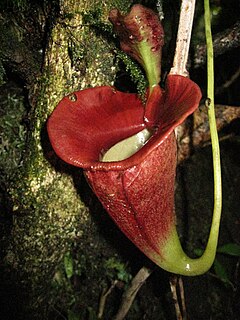
Nepenthes jacquelineae is a tropical pitcher plant endemic to the Indonesian island of Sumatra. Due to its unique pitcher morphology, it is considered to be one of the most spectacular Nepenthes species native to the island.

Nepenthes tenuis is a tropical pitcher plant endemic to the Indonesian island of Sumatra. The species was first collected in 1957, from a remote mountain in the western part of the island. It remained undescribed until 1994, and was only rediscovered in the wild in 2002. Prior to this, N. tenuis was known solely from a single photograph and dried herbarium specimen.

Nepenthes rigidifolia is a critically endangered tropical pitcher plant endemic to Sumatra, where it grows at elevations of 1000–1600 m above sea level.
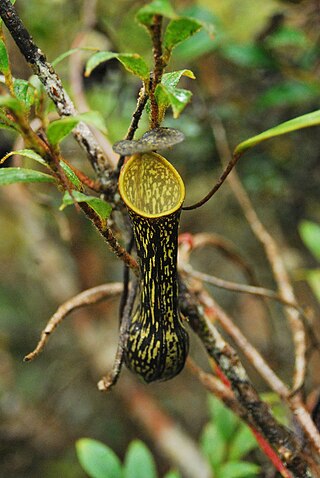
Nepenthes mikei is a tropical pitcher plant endemic to Sumatra. It is characterised by its black mottled lower and upper pitchers. The species is closely related to N. angasanensis and N. tobaica.

Cirsium pitcheri, sometimes called Pitcher's thistle or dune thistle, is a species of thistle native to sand dune shorelines along the upper Great Lakes. It is native to Indiana, Illinois, Michigan, Wisconsin, and Ontario. It is listed by the U.S. Fish and Wildlife Service as a threatened species.

Viburnum nudum is a deciduous shrub in the genus Viburnum within the muskroot family, Adoxaceae.

Carnivorous plants are plants that derive some or most of their nutrients from trapping and consuming animals or protozoans, typically insects and other arthropods. Carnivorous plants still generate some of their energy from photosynthesis. Carnivorous plants have adapted to grow in places where the soil is thin or poor in nutrients, especially nitrogen, such as acidic bogs. They can be found on all continents except Antarctica, as well as many Pacific islands. In 1875 Charles Darwin published Insectivorous Plants, the first treatise to recognize the significance of carnivory in plants, describing years of painstaking research.
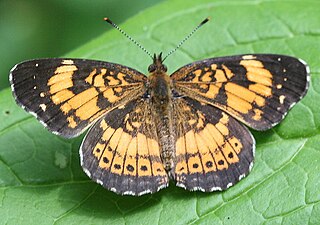
Chlosyne nycteis, the silvery checkerspot, is a species of Nymphalinae butterfly that occurs in North America. It is listed as a species of special concern in Connecticut and Maine, and is believed extirpated in Connecticut, Massachusetts, and New Hampshire.
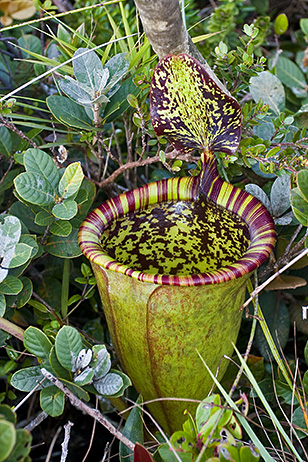
Nepenthes attenboroughii, or Attenborough's pitcher plant, is a montane species of carnivorous pitcher plant of the genus Nepenthes. It is named after the celebrated broadcaster and naturalist Sir David Attenborough, who is a keen enthusiast of the genus. The species is characterised by its large and distinctive bell-shaped lower and upper pitchers and narrow, upright lid. The type specimen of N. attenboroughii was collected on the summit of Mount Victoria, an ultramafic mountain in central Palawan, the Philippines.

Psectraglaea is a monotypic moth genus of the family Noctuidae described by George Hampson in 1906. Its only species, Psectraglaea carnosa, the pink sallow, described by Augustus Radcliffe Grote in 1877, is native to North America. It is listed as threatened in Connecticut, and as a species of special concern in Massachusetts.

The Appalachian azure is a butterfly in the gossamer wings family Lycaenidae. The male is light blue on the upperwing with a narrow, dark line running along the edge of the forewing. The underwing is chalky white and is dotted with small, pale dark spots. The very back of the hindwing has a row of dark spots running along the edge and contained by a faint zigzagging band. Females are similar to the males but have broad dark wing borders instead of the male's narrow ones. The adult butterfly has a 1.1–1.4-inch (2.8–3.6 cm) wingspan. It is the largest azure in the area.

Callophrys irus, the frosted elfin, is a species of Lycaenidae that is native to North America.

Nepenthes kerrii is a tropical pitcher plant native to Tarutao National Marine Park in southern Thailand, where it grows at elevations of 400–500 m above sea level. The 2018 IUCN assessment also considers the taxon found on Langkawi Island of Malaysia to be conspecific. This species is thought to be most closely related to N. kongkandana.
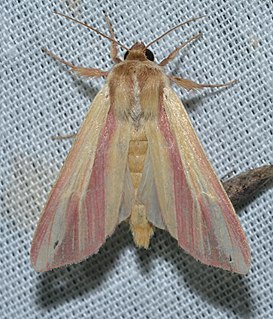
Dargida rubripennis, the pink streak, is a species of moth in the family Noctuidae. It was described by Augustus Radcliffe Grote and Coleman Townsend Robinson in 1870. It is found in the eastern United States, ranging to Kansas and Texas. It is listed as threatened in the US states of Massachusetts and Connecticut. The wingspan is 32–37 mm. The forewings are yellowish-white, with dull pink streaks and shaded with dull pink at the outer margin. The hindwings are white, also shaded with dull pink. Adults are on wing from January to February and from July to October. Its preferred larval host plant is Switchgrass.
Papaipema appassionata, the pitcher plant borer, is a species of moth described by Leon F. Harvey in 1876. It is native to North America, where it has been recorded from Florida, Maine, Maryland, Massachusetts, Michigan, Minnesota, New Brunswick, Quebec, Rhode Island, South Carolina and Wisconsin. It is listed as threatened in the US state of Connecticut.

Sideridis maryx the maroonwing moth, is a species of moth native to North America. In the US state of Connecticut, it is listed as a species of special concern and is believed to be extirpated. The larval food plant is unknown, but it is suspected to be a specialist feeding on Arctostaphylos uva-ursi. The species was first described by Achille Guenée in 1852.
References
- ↑ "Connecticut's Endangered, Threatened and Special Concern Species 2015". State of Connecticut Department of Energy and Environmental Protection Bureau of Natural Resources. Retrieved 19 January 2018.
- ↑ "Species Exyra fax - Epauletted Pitcher-plant Moth - Hodges#9021".